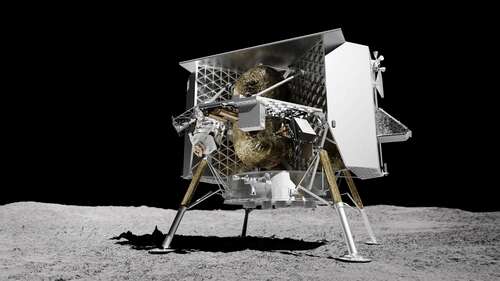
After a successful launch yesterday, a failure in the Peregrine propulsion system depleted its propellant, most likely putting an end to its moon landing hopes.
Peregrine, the moon lander carrying NASA instruments that launched into space yesterday, is unlikely to complete its objective of making a soft landing on the lunar surface after a fuel leak was detected that is preventing it from pointing towards the sun for solar power.
Built by Pittsburgh-based Astrobotic, the Peregrine moon lander is the first of several landers built by US private companies scheduled to attempt soft landings on the moon this year. It lifted off early morning from Florida yesterday (8 January) aboard the Vulcan rocket built by US aerospace manufacturer United Launch Alliance.
While the launch was successful, a failure in the lander’s propulsion system depleted its propellant, most likely putting an end to its moon landing hopes.
(1/4) We’ve received the first image from Peregrine in space! The camera utilized is mounted atop a payload deck and shows Multi-Layer Insulation (MLI) in the foreground. pic.twitter.com/dUuu0Idz8K
— Astrobotic (@astrobotic) January 8, 2024
Astrobotic released a statement earlier today saying that an ongoing propellant leak is causing the spacecraft’s Attitude Control System thrusters to operate well beyond their expected life cycles to keep the lander from “an uncontrollable tumble”.
“If the thrusters can continue to operate, we believe the spacecraft [Peregrine] could continue in a stable sun-pointing state for approximately 40 more hours based on current fuel consumption,” the company wrote in a statement.
“At this time, the goal is to get Peregrine as close to lunar distance as we can before it loses the ability to maintain its sun-pointing position and subsequently loses power.”
Soon after, NASA issued a statement that acknowledged the propulsion issue and said it was working with Astrobotic to identify the root cause of the issue to see how it affects the five instruments the agency paid to have aboard Peregrine.
Each mission is an opportunity to learn. We’re proud to work with our partners to advance exploration of the Moon,” NASA wrote. “Space is hard. We support our vendors and look forward to learning all we can.”
With the success of @ulalaunch‘s #VulcanRocket, our country has more tools to explore space. Spaceflight is a daring adventure, and @astrobotic is making progress for CLPS deliveries and Artemis. @NASA will continue to expand our reach in the cosmos with our commercial partners. https://t.co/YqXKR7fRXz
— Bill Nelson (@SenBillNelson) January 8, 2024
Peregrine is the first of the missions under NASA’s Commercial Lunar Payload Services (CLPS) programme to be launched into space since the initiative was announced in 2018. It is the result of NASA’s increasing willingness to rely on commercial companies to reduce costs.
“What we have learned from our commercial partners is if we have a high enough cadence, we can relax some of the requirements that make it so costly, and have a higher risk appetite,” deputy administrator Pam Melroy told the BBC last month. “And if they fail, the next one is going to learn and succeed.”
Last year, India’s Vikram lander carrying the Pragyaan rover made a historic soft landing on the lunar south pole, making it the first country to achieve the feat and the fourth to land on the moon.
The landing came just two days after Russia’s Luna-25 mission, which was attempting to land in the same region as India, crashed into the lunar surface after running into difficulties.
10 things you need to know direct to your inbox every weekday. Sign up for the Daily Brief, Silicon Republic’s digest of essential sci-tech news.

